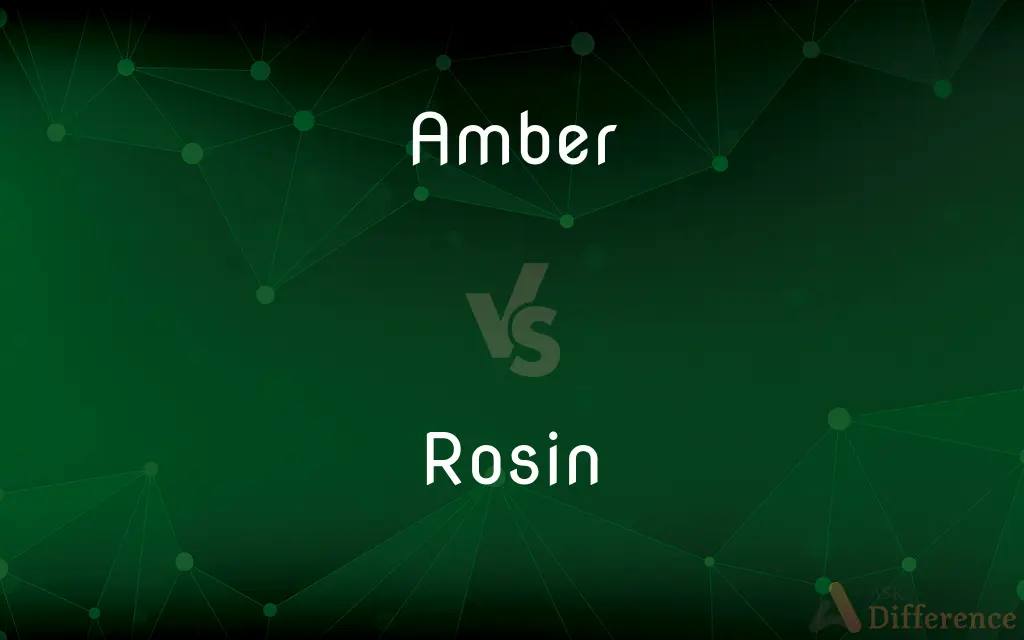Amber vs. Rosin — What's the Difference?
By Maham Liaqat & Urooj Arif — Updated on April 1, 2024
Amber is a fossilized tree resin admired for its color and natural beauty, while rosin is a solid form of resin obtained from pines and some other plants, used mainly for its adhesive properties.

Difference Between Amber and Rosin
Table of Contents
ADVERTISEMENT
Key Differences
Amber, being fossilized tree resin, has been cherished through millennia for its ornamental value and occasional preservation of ancient life. Whereas, rosin, derived from living plants, primarily serves utilitarian purposes in industries like music and sports for its friction-enhancing qualities.
Amber’s formation process spans over millions of years, involving gradual hardening and fossilization of tree resin. On the other hand, rosin is collected through a much quicker process by heating fresh resin to separate the volatile liquid terpenes from the solid rosin.
The appearance of amber can vary from pale yellow to brown and is often transparent or translucent, making it highly valued in jewelry. In contrast, rosin is generally yellowish to black, opaque, and lacks the aesthetic appeal that makes amber so sought after.
Amber can sometimes contain ancient inclusions such as insects or plant matter, offering a fascinating glimpse into prehistoric ecosystems. Rosin, however, is valued for its purity and consistency in applications such as improving grip on violin bows or dancers’ shoes.
While amber is primarily used in decorative objects, jewelry, and in some traditional medicines, rosin finds its application in manufacturing processes, as a flux in soldering, and in the maintenance of stringed instruments, showcasing their divergent uses stemming from their distinct properties.
ADVERTISEMENT
Comparison Chart
Origin
Fossilized tree resin
Solid form of resin from pines and other plants
Age
Millions of years
Contemporary
Color
Pale yellow to brown, transparent/translucent
Yellowish to black, opaque
Uses
Jewelry, decorative items
Music (bow grip), sports (grip), soldering flux
Unique Aspect
Can contain prehistoric inclusions
Used for its adhesive and friction-enhancing properties
Compare with Definitions
Amber
Fossilized Resin.
The necklace was made of amber, showcasing its beautiful, warm glow.
Rosin
Resin Derivative.
Rosin is used on the bow of string instruments to prevent slipping on the strings.
Amber
Prehistoric Inclusions.
This piece of amber contains an insect, capturing a moment from millions of years ago.
Rosin
Transparent to Opaque.
Despite its opacity, rosin is indispensable in certain crafts.
Amber
Varied Colors.
Amber's color palette ranges from yellow to deep orange.
Rosin
Natural Source.
Rosin is collected from pine trees, making it a renewable resource.
Amber
Therapeutic Claims.
Amber is sometimes worn for its purported healing properties.
Rosin
Industrial Applications.
Rosin is applied in soldering to enhance the flow of solder.
Amber
Ornamental Use.
Amber beads are often used in jewelry due to their natural beauty.
Rosin
Grip Enhancement.
Gymnasts use rosin to improve their grip on apparatus.
Amber
Amber is fossilized tree resin that has been appreciated for its color and natural beauty since Neolithic times. Much valued from antiquity to the present as a gemstone, amber is made into a variety of decorative objects.
Rosin
Resin, especially the solid amber residue obtained after the distillation of crude turpentine oleoresin, or of naphtha extract from pine stumps. It is used in adhesives, varnishes, and inks and for treating the bows of stringed instruments
Liquid rosin flux
They will also supply crushed colophony rosin
Amber
Hard translucent fossilized resin originating from extinct coniferous trees of the Tertiary period, typically yellowish in colour. It has been used in jewellery since antiquity.
Rosin
Rosin (/ˈɹɒ.zən/), also called colophony or Greek pitch (Latin: pix graeca), is a solid form of resin obtained from pines and some other plants, mostly conifers, produced by heating fresh liquid resin to vaporize the volatile liquid terpene components. It is semi-transparent and varies in color from yellow to black.
Amber
A hard, translucent, usually brownish-yellow fossil resin, used for making jewelry and other ornamental objects.
Rosin
Rub (something, especially a violin bow or string) with rosin
Island musicians are rosining their bows
Amber
A brownish yellow.
Rosin
A translucent yellowish to dark brown resin derived from the stumps or sap of various pine trees, composed chiefly of abietic acid and related compounds, and used to increase sliding friction, as on the bows of certain stringed instruments, and to manufacture a wide variety of products including varnishes, inks, linoleum, adhesives, and soldering compounds. Also called colophony.
Amber
Having the color of amber; brownish-yellow.
Rosin
To coat or rub with rosin.
Amber
Made of or resembling amber
An amber necklace.
Rosin
(organic chemistry) A solid form of resin, obtained from liquid resin by vaporizing its volatile components.
Amber
(obsolete) Ambergris, the waxy product of the sperm whale.
Rosin
Resin.
Amber
A hard, generally yellow to brown translucent fossil resin, used for jewellery. One variety, blue amber, appears blue rather than yellow under direct sunlight.
Rosin
(transitive) To apply rosin to (something); to rub or cover with rosin.
We waited expectantly as the guest violinist rosined his bow in preparation for playing.
Amber
A yellow-orange colour.
Rosin
The hard, amber-colored resin left after distilling off the volatile oil of turpentine; colophony.
Amber
(British) The intermediate light in a set of three traffic lights, which when illuminated indicates that drivers should stop short of the intersection when safe to do so.
Rosin
To rub with rosin, as musicians rub the bow of a violin.
Or with the rosined bow torment the string.
Amber
The stop codon (nucleotide triplet) "UAG", or a mutant which has this stop codon at a premature place in its DNA sequence.
An amber codon, an amber mutation, an amber suppressor
Rosin
Any of a class of solid or semisolid viscous substances obtained either as exudations from certain plants or prepared by polymerization of simple molecules
Amber
(uncountable) Hesitance to proceed, or limited approval to proceed; an amber light.
Rosin
Rub rosin onto;
Rosin the violin bow
Amber
Of a brownish yellow colour, like that of most amber.
Amber
To perfume or flavour with ambergris.
Ambered wine, an ambered room
Amber
To preserve in amber.
An ambered fly
Amber
To cause to take on the yellow colour of amber.
Amber
To take on the yellow colour of amber.
Amber
A yellowish translucent resin resembling copal, found as a fossil in alluvial soils, with beds of lignite, or on the seashore in many places. It takes a fine polish, and is used for pipe mouthpieces, beads, etc., and as a basis for a fine varnish. By friction, it becomes strongly electric.
Amber
Amber color, or anything amber-colored; a clear light yellow; as, the amber of the sky.
Amber
Ambergris.
You that smell of amber at my charge.
Amber
The balsam, liquidambar.
Amber
Consisting of amber; made of amber.
Amber
Resembling amber, especially in color; amber-colored.
Amber
To scent or flavor with ambergris; as, ambered wine.
Amber
To preserve in amber; as, an ambered fly.
Amber
A deep yellow color;
An amber light illuminated the room
He admired the gold of her hair
Amber
A hard yellowish to brownish translucent fossil resin; used for jewelry
Amber
A medium to dark brownish yellow color
Common Curiosities
Is all rosin the same?
No, rosin can vary in quality and consistency depending on its source and the process used to produce it.
How is rosin produced?
Rosin is produced by heating fresh pine resin, allowing the volatile terpenes to evaporate, leaving behind solid rosin.
Does amber always contain inclusions?
Not all amber contains inclusions; however, pieces that do are particularly valued for their scientific and aesthetic significance.
How can you tell real amber from fake?
Tests for authenticity include examining inclusions, checking for fluorescence under UV light, and observing the warmth and buoyancy of the material.
Can rosin be reused or recycled?
While rosin can degrade over time, its use is generally maximized until it becomes ineffective.
Can amber be artificially created?
While synthetic resins can mimic the appearance of amber, true amber is a natural, fossilized material that cannot be artificially created.
What are the main uses of rosin?
Rosin is widely used in the music industry to treat bow strings, in sports for grip enhancement, and as a flux in soldering.
Are there different types of rosin for different uses?
Yes, rosins are formulated differently for various applications, such as for violin bows versus ballet shoes.
Does rosin affect the sound of a musical instrument?
Yes, applying rosin to the bow of stringed instruments improves the grip on the strings, affecting the quality of the sound produced.
How long does it take for tree resin to turn into amber?
The process of turning tree resin into amber takes millions of years, involving gradual fossilization.
What is amber made of?
Amber is fossilized tree resin that has undergone a natural hardening process over millions of years.
Why is amber considered valuable?
Amber is valued for its natural beauty, rarity, and the unique inclusions it may contain, offering a glimpse into prehistoric life.
Is rosin safe to handle?
Yes, rosin is safe to handle, though some people may experience allergic reactions to pine resin.
Can the color of amber vary?
Yes, the color of amber can range from pale yellow to deep orange or even red, depending on its origin and conditions of fossilization.
What are the ecological implications of amber extraction?
Amber extraction can have ecological impacts, including habitat disruption. Sustainable practices and regulations are important to minimize environmental damage.
Share Your Discovery

Previous Comparison
Overshoot vs. Undershoot
Next Comparison
Paper vs. TissueAuthor Spotlight
Written by
Maham LiaqatCo-written by
Urooj ArifUrooj is a skilled content writer at Ask Difference, known for her exceptional ability to simplify complex topics into engaging and informative content. With a passion for research and a flair for clear, concise writing, she consistently delivers articles that resonate with our diverse audience.
















































